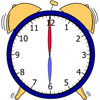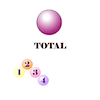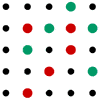Skip over navigation
Article by Jennie Pennant and Liz Woodham
One of the essential mathematical problem-solving skills that we want to help children to develop is that of logical thinking: 'if this ... then that'. Strategy games are a great way to offer children the opportunity to develop this skill in a stimulating environment. Most of us are familiar with strategy games such as chess, draughts and noughts and crosses: here on the NRICH site we have a range of other strategy games, including some that can be played against the computer. This is great for encouraging the children to play at home.
Strategy games are low threshold high ceiling tasks where all children can easily access the game at its basic level and play 'randomly'. The high ceiling is developing a winning strategy and communicating that effectively, in writing, to others.
How could you structure a strategy game in the classroom?
Let's look at a basic version of the ancient game of Nim: Nim-7, a game for two players.
How to play
1. Make a pile of seven counters or other interesting objects. This could be played outside with pebbles, sticks or shells.

2. Players take it in turn to remove either one or two counters/objects from the pile.
3. To win you need to take the last counter or counters.
The lesson
To start with, invite the children to play the game several times to get used to how it works. Everyone can have a go at playing randomly.
However, you may soon notice some of them start looking for a way to win.
Draw everyone's attention to this, using a mini plenary, and start thinking together as a class about how to win.
Look out for children who are discussing whether it matters who goes first and draw everyone's attention to this.
Encourage the children to record their moves and help them to articulate their ideas about strategy with sentences such as, 'I noticed that when I ..., xxxx happened'.
Encourage them to think more than one step ahead: 'If I do this, then xxxx may happen and then I can xxxx. This would be useful because ...'.
Also encourage the children to articulate a hypothesis of 'how to win' and to try out their hypothesis a number of times. If it fails, they need to develop a new hypothesis.
Encourage children who think they have different winning hypotheses to play against each other and see what happens. Opponents will soon become partners in investigation as they test their hypotheses.
Children may like to try out their winning strategy at home or with a child in another class at playtime.
Encourage them to think abut how they can record their winning strategy, maybe in the form of Top Tips.
You can encourage the children to think about 'What if ”¦?' questions, such as what happens if you start the game with a different number of counters? (A series of key numbers will emerge, as well as some interesting observations about odds, evens and multiples.)
There is the potential here for a series of lessons. Focus with the children on the development of their logical thinking 'if this ... then that' and see how it develops over a number of games. Can they use the skills they have learnt playing Nim-7 in another game?
Games with the same isomorphic structure: Games related to Nim
In this Strategy Games Feature, we offer a variety of strategy games suitable for primary children. Firstly, let's focus on the family of Nim games. The games in this family are isomorphic, meaning they have essentially the same structure. Here we outline a form of progression in using them.
 A good place to start is with Nim-7, as outlined above. Once children have developed a winning strategy, challenge them to have a go at Stop the Clock, which is the same Nim structure, but in the context of time. In this game for two players, the clock face starts at
6 o'clock and the goal is to get to 12 o'clock by taking it in turns to move the hands of the clock on by either half an hour or an hour. So, the half hour or hour added on is analogous to the one or two counters taken away in Nim-7. The interactivity allows learners to play the game easily without worrying about recording at first. Often someone will notice that if their
opponent has left the clock showing 10.30, it is impossible to win. In this way, a strategy might emerge which involves working backwards from 12 o'clock.
A good place to start is with Nim-7, as outlined above. Once children have developed a winning strategy, challenge them to have a go at Stop the Clock, which is the same Nim structure, but in the context of time. In this game for two players, the clock face starts at
6 o'clock and the goal is to get to 12 o'clock by taking it in turns to move the hands of the clock on by either half an hour or an hour. So, the half hour or hour added on is analogous to the one or two counters taken away in Nim-7. The interactivity allows learners to play the game easily without worrying about recording at first. Often someone will notice that if their
opponent has left the clock showing 10.30, it is impossible to win. In this way, a strategy might emerge which involves working backwards from 12 o'clock.
 Working backwards is also a helpful strategy in Got It, one of our favourite NRICH resources. In this version of Nim, you have the opportunity to play against the computer. Players take turns to add a whole number from 1 to 4 to the running total. The player who hits the target
of 23 wins the game. So in this game, the target of 23 is analogous to Stop the Clock's 12 o'clock and this time, rather than adding on half an hour or an hour, we can add on 1, 2, 3 or 4.
Working backwards is also a helpful strategy in Got It, one of our favourite NRICH resources. In this version of Nim, you have the opportunity to play against the computer. Players take turns to add a whole number from 1 to 4 to the running total. The player who hits the target
of 23 wins the game. So in this game, the target of 23 is analogous to Stop the Clock's 12 o'clock and this time, rather than adding on half an hour or an hour, we can add on 1, 2, 3 or 4.
Once again, give lots of time for children to play the game without worrying too much about strategy so they really get a feel for it. Do they notice any similarities between Got It and Stop the Clock or Nim-7? How can they use what they found out in the previous games to help them beat the computer at Got It?
Although the previous versions of Nim already discussed are fully generalisable for any number of counters in the case of Nim-7 or any end time and any length of time added on in the case of Stop the Clock, somehow the context of Got It is often very motivating for children. Beating the computer is something special! Therefore Got It has the potential to really challenge learners to extend their strategy to be generalisable. A possible sequence of challenges could look like this:
Can they work out a strategy for the game as it stands, with a target of 23 and numbers 1-5?
Can they work out a strategy for a target of 25 and numbers 1-5?
Can they work out a strategy for a target of 24 and numbers 1-5?
Can they work out a strategy for a target of 23 and numbers 1-6?
Can they work out a strategy for any target and any range of consecutive numbers starting with 1?
There is nothing quite like Got It for communicating the power of mathematics to young children. Using basic addition and subtraction, along with perhaps some knowledge of factors and multiples, they can beat the computer (or a friend) no matter what the target number and what the range of numbers. You may also be interested in our Got It Article, which gives more detailed ideas for understanding the game and finding a winning strategy.
Why not add an extra challenge for some in your class and change the rules of one of these Nim games? For example, in Nim-7, how would your strategy change if the loser picks the last counter?
If you would like another example of isomorphic games, take a look at Noughts and Crosses, which links to three other similar games. The article Winning Lines explores the structure and possible progression of these games in more detail.
Other strategy games
 For another numerical strategy game, have a go at The Factors and Multiples Game. We have chosen to include this in our Strategy Games Feature as the motivating context and decision-making involved mean it is a fantastic replacement for standard 'exercises' on finding
factors and multiples. In addition of course, it encourages the development of logical thinking as already described. Depending on your learners' experiences, you could initially present the game on a 1-50 grid. Give them time to play in pairs, perhaps for a short period of time every day over the course of a few weeks. This will help them become immersed in the game so
they are very familiar with it. You can then move on to the idea of strategy. Look out for those children who consider the role of prime numbers in the game. You may want to include some mini plenaries to draw out key ideas. Have a look at the teachers' resources section of the game for a suggested cooperative version too.
For another numerical strategy game, have a go at The Factors and Multiples Game. We have chosen to include this in our Strategy Games Feature as the motivating context and decision-making involved mean it is a fantastic replacement for standard 'exercises' on finding
factors and multiples. In addition of course, it encourages the development of logical thinking as already described. Depending on your learners' experiences, you could initially present the game on a 1-50 grid. Give them time to play in pairs, perhaps for a short period of time every day over the course of a few weeks. This will help them become immersed in the game so
they are very familiar with it. You can then move on to the idea of strategy. Look out for those children who consider the role of prime numbers in the game. You may want to include some mini plenaries to draw out key ideas. Have a look at the teachers' resources section of the game for a suggested cooperative version too.
 Some Games That May Be Nice or Nasty is also a wonderful strategy game which develops children's understanding of place value. It is easily adaptable to suit learners in lower primary, even though as it is written for upper primary children. The game begins with the well-known idea of
throwing a dice and having to use that number as one digit in a four-digit number. The dice is thrown three more times to complete the number. What strategy do you use if you're aiming for the highest possible number? And the lowest? The further variations offered increase the challenge, for example by having a target to aim for or by introducing a decimal
point. The 'nasty' version allows you to keep the number you have thrown or decide to give it to someone else! Like The Factors and Multiples Game, there is also a cooperative version, which of course alters the strategy completely and stimulates plenty of discussion between learners.
Some Games That May Be Nice or Nasty is also a wonderful strategy game which develops children's understanding of place value. It is easily adaptable to suit learners in lower primary, even though as it is written for upper primary children. The game begins with the well-known idea of
throwing a dice and having to use that number as one digit in a four-digit number. The dice is thrown three more times to complete the number. What strategy do you use if you're aiming for the highest possible number? And the lowest? The further variations offered increase the challenge, for example by having a target to aim for or by introducing a decimal
point. The 'nasty' version allows you to keep the number you have thrown or decide to give it to someone else! Like The Factors and Multiples Game, there is also a cooperative version, which of course alters the strategy completely and stimulates plenty of discussion between learners.
 Finally, we suggest you try Seeing Squares, a spatial strategy game, suitable for learners of all ages. The game can be played against the computer, or against a friend. Players take it in turns to click on a dot on the grid (or place counters on a grid) and the winner is the first to
have four dots or counters that can be joined by straight lines to form a square. At its most basic level, this game reinforces the properties of a square, but in trying to find a winning strategy, children will need to work systematically. Like Got It, having the opportunity to play against the computer is invaluable as by carefully watching the computer's moves,
learners can identify patterns, which help to reveal a strategy.
Finally, we suggest you try Seeing Squares, a spatial strategy game, suitable for learners of all ages. The game can be played against the computer, or against a friend. Players take it in turns to click on a dot on the grid (or place counters on a grid) and the winner is the first to
have four dots or counters that can be joined by straight lines to form a square. At its most basic level, this game reinforces the properties of a square, but in trying to find a winning strategy, children will need to work systematically. Like Got It, having the opportunity to play against the computer is invaluable as by carefully watching the computer's moves,
learners can identify patterns, which help to reveal a strategy.
Encouraging children to enjoy the challenge of strategy games beyond the classroom
Outdoors
Strategy games are a great way to enjoy some mathematics with family and friends outdoors in the summer holidays. In 2012 we put together this set of Strategy Games from Around the World, as it was the Olympic year. Take a look at this set and see how you could encourage children to play them over the summer.
On the computer
Got It and Seeing Squares are both examples of strategy games that can be played on the computer - very useful for wet days in the holidays perhaps. Who can become a 'Got It' champion?
And finally
Enjoy exploring the NRICH collections of strategy games with the children and see how it promotes their logical thinking skills. Do encourage them to become aware themselves of how it is developing this skill. After enjoying some of the strategy games together you may like to see how the children can apply their skills to other problems that require logical thought such as One of Thirty-six, What Do You Need? or Fifteen Cards.
Further reading
Jenny Piggot's article Meet the Nim Family offers guidance on using games generally in the classroom and then focuses specifically on some versions of Nim. For ideas to extend Nim games even further take a look at variations of the game in Jenni Way's last article in the Learning Mathematics Through Games series.
Here is a PDF version of this article.
Or search by topic
Number and algebra
Geometry and measure
Probability and statistics
Working mathematically
Advanced mathematics
For younger learners
Age 5 to 11
Published 2013 Revised 2020
Developing Logical Thinking: the Place of Strategy Games
One of the essential mathematical problem-solving skills that we want to help children to develop is that of logical thinking: 'if this ... then that'. Strategy games are a great way to offer children the opportunity to develop this skill in a stimulating environment. Most of us are familiar with strategy games such as chess, draughts and noughts and crosses: here on the NRICH site we have a range of other strategy games, including some that can be played against the computer. This is great for encouraging the children to play at home.
Strategy games are low threshold high ceiling tasks where all children can easily access the game at its basic level and play 'randomly'. The high ceiling is developing a winning strategy and communicating that effectively, in writing, to others.
How could you structure a strategy game in the classroom?
Let's look at a basic version of the ancient game of Nim: Nim-7, a game for two players.
How to play
1. Make a pile of seven counters or other interesting objects. This could be played outside with pebbles, sticks or shells.

2. Players take it in turn to remove either one or two counters/objects from the pile.
3. To win you need to take the last counter or counters.
The lesson
To start with, invite the children to play the game several times to get used to how it works. Everyone can have a go at playing randomly.
However, you may soon notice some of them start looking for a way to win.
Draw everyone's attention to this, using a mini plenary, and start thinking together as a class about how to win.
Look out for children who are discussing whether it matters who goes first and draw everyone's attention to this.
Encourage the children to record their moves and help them to articulate their ideas about strategy with sentences such as, 'I noticed that when I ..., xxxx happened'.
Encourage them to think more than one step ahead: 'If I do this, then xxxx may happen and then I can xxxx. This would be useful because ...'.
Also encourage the children to articulate a hypothesis of 'how to win' and to try out their hypothesis a number of times. If it fails, they need to develop a new hypothesis.
Encourage children who think they have different winning hypotheses to play against each other and see what happens. Opponents will soon become partners in investigation as they test their hypotheses.
Children may like to try out their winning strategy at home or with a child in another class at playtime.
Encourage them to think abut how they can record their winning strategy, maybe in the form of Top Tips.
You can encourage the children to think about 'What if ”¦?' questions, such as what happens if you start the game with a different number of counters? (A series of key numbers will emerge, as well as some interesting observations about odds, evens and multiples.)
There is the potential here for a series of lessons. Focus with the children on the development of their logical thinking 'if this ... then that' and see how it develops over a number of games. Can they use the skills they have learnt playing Nim-7 in another game?
Games with the same isomorphic structure: Games related to Nim
In this Strategy Games Feature, we offer a variety of strategy games suitable for primary children. Firstly, let's focus on the family of Nim games. The games in this family are isomorphic, meaning they have essentially the same structure. Here we outline a form of progression in using them.
Once again, give lots of time for children to play the game without worrying too much about strategy so they really get a feel for it. Do they notice any similarities between Got It and Stop the Clock or Nim-7? How can they use what they found out in the previous games to help them beat the computer at Got It?
Although the previous versions of Nim already discussed are fully generalisable for any number of counters in the case of Nim-7 or any end time and any length of time added on in the case of Stop the Clock, somehow the context of Got It is often very motivating for children. Beating the computer is something special! Therefore Got It has the potential to really challenge learners to extend their strategy to be generalisable. A possible sequence of challenges could look like this:
Can they work out a strategy for the game as it stands, with a target of 23 and numbers 1-5?
Can they work out a strategy for a target of 25 and numbers 1-5?
Can they work out a strategy for a target of 24 and numbers 1-5?
Can they work out a strategy for a target of 23 and numbers 1-6?
Can they work out a strategy for any target and any range of consecutive numbers starting with 1?
There is nothing quite like Got It for communicating the power of mathematics to young children. Using basic addition and subtraction, along with perhaps some knowledge of factors and multiples, they can beat the computer (or a friend) no matter what the target number and what the range of numbers. You may also be interested in our Got It Article, which gives more detailed ideas for understanding the game and finding a winning strategy.
Why not add an extra challenge for some in your class and change the rules of one of these Nim games? For example, in Nim-7, how would your strategy change if the loser picks the last counter?
If you would like another example of isomorphic games, take a look at Noughts and Crosses, which links to three other similar games. The article Winning Lines explores the structure and possible progression of these games in more detail.
Other strategy games
Encouraging children to enjoy the challenge of strategy games beyond the classroom
Outdoors
Strategy games are a great way to enjoy some mathematics with family and friends outdoors in the summer holidays. In 2012 we put together this set of Strategy Games from Around the World, as it was the Olympic year. Take a look at this set and see how you could encourage children to play them over the summer.
On the computer
Got It and Seeing Squares are both examples of strategy games that can be played on the computer - very useful for wet days in the holidays perhaps. Who can become a 'Got It' champion?
And finally
Enjoy exploring the NRICH collections of strategy games with the children and see how it promotes their logical thinking skills. Do encourage them to become aware themselves of how it is developing this skill. After enjoying some of the strategy games together you may like to see how the children can apply their skills to other problems that require logical thought such as One of Thirty-six, What Do You Need? or Fifteen Cards.
Further reading
Jenny Piggot's article Meet the Nim Family offers guidance on using games generally in the classroom and then focuses specifically on some versions of Nim. For ideas to extend Nim games even further take a look at variations of the game in Jenni Way's last article in the Learning Mathematics Through Games series.
Here is a PDF version of this article.

